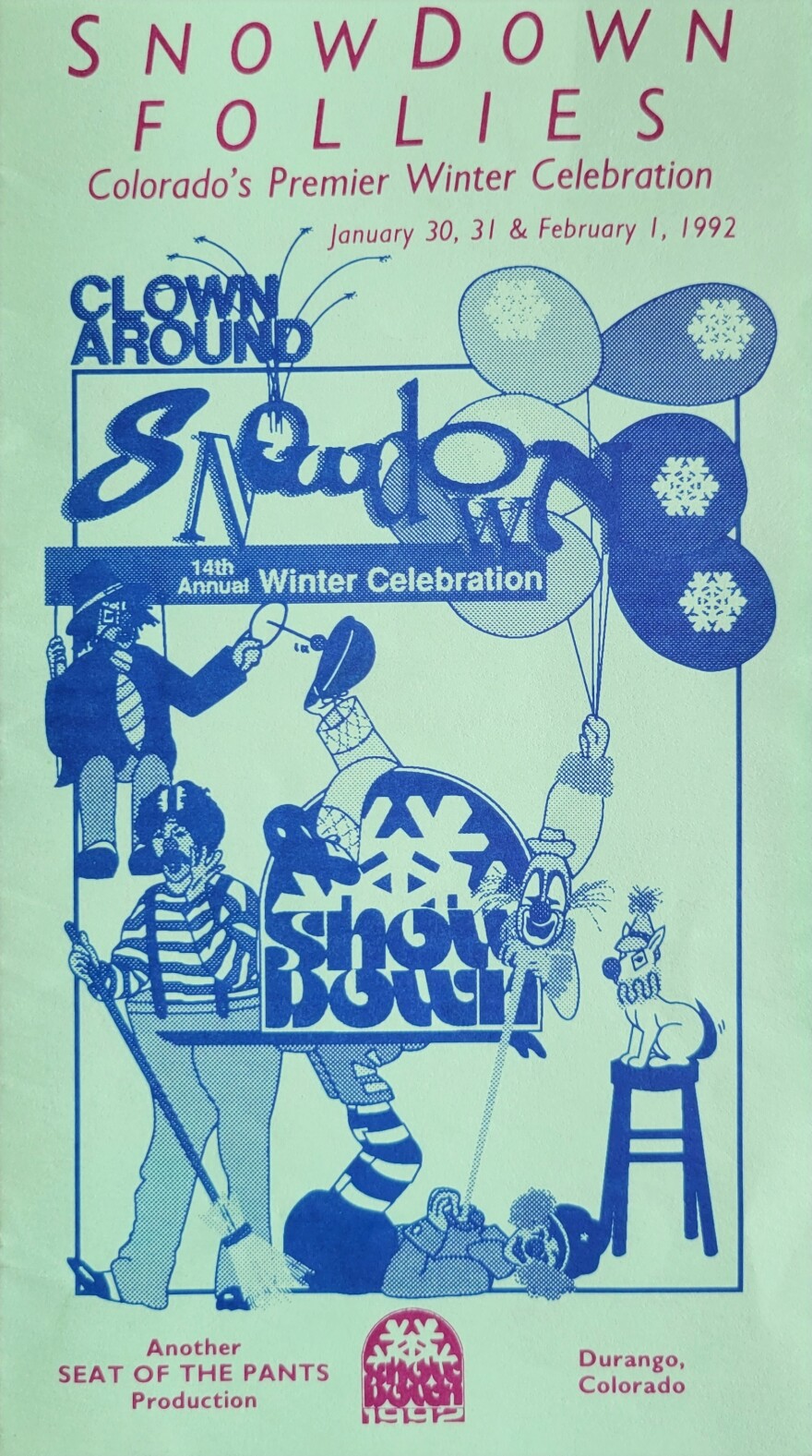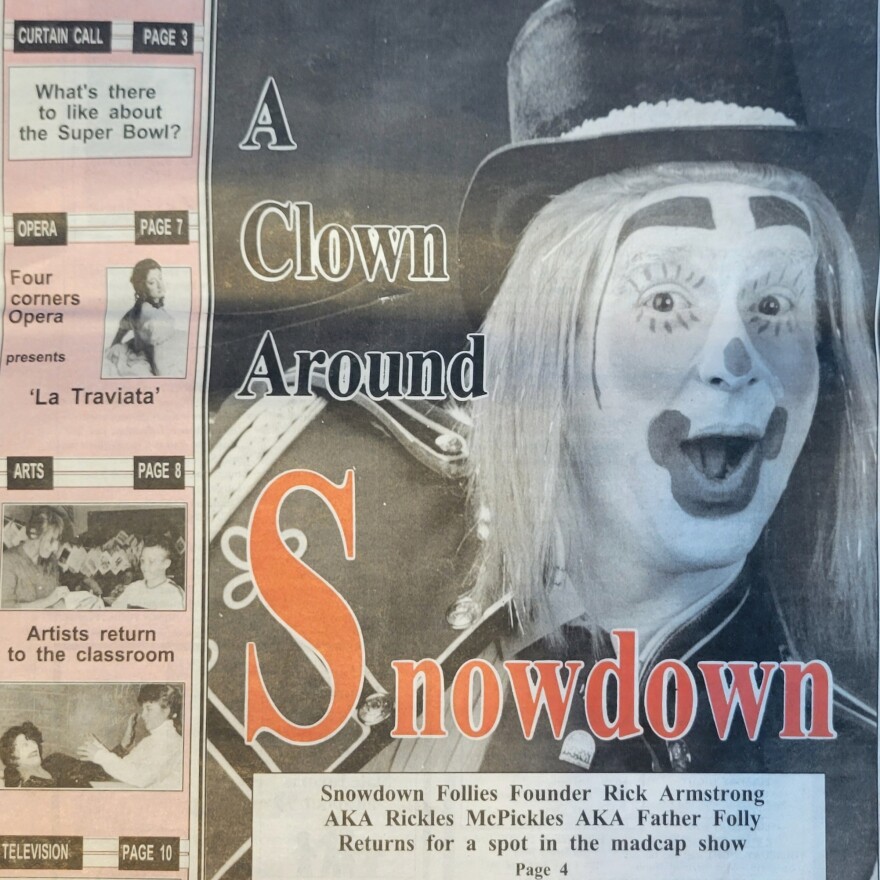Listen to the episode
Every year in late January, Durango throws a big costume party. It’s an annual winter festival called Snowdown. In its 45-year history, Snowdown has featured many themes, such as pirates, superheroes, and safaris.
“Hopefully, we pick something that's going to be fun that lends itself to a lot of different events and good costumes,” says Peg Ochsenreiter, a long-time Snowdown organizer. “Part of Snowdown is everybody dresses up.”
Over the years, the streets, restaurants, and bars have overflowed with hippies, cowboys, Romans, and aliens from the future. But in 1992, Snowdown turned Durango into a big-top circus show, minus the acrobats, daredevils, and large animals. That was the year known as “Clown Around Snowdown.” People in town put on big shoes, giant multicolored wigs, and bright red noses for five full days.
Ochsenreiter is also the festival’s historian. On a clear winter morning at her house, Ochsenreiter covered a dinner table with decades of Snowdown memorabilia. “We had a clown makeup workshop,” she recalled while perusing the 1992 Snowdown schedule.
“There were red noses everywhere,” she said.

The view into the rearview mirror 30 years back can be a little hazy, but other long-time Snowdown volunteers also remember a sea of red noses.
“I think they held a contest for the greatest number of red noses in one location,” recalls Janalee Hogan, the longtime finance director for the festival.
For anyone who loves clowns and clowning around, 1992 was the year to be in Durango. But what about the people who don’t want anything to do with clowns? It’s a very real fear known as coulrophobia.
In a multi-year survey documenting American fears, academics at Chapman University found that fear of clowns hovers between 5 and 8 percent. That’s not a huge number, but it’s not negligible either.
Other studies have looked into why. One reason is that clowns can be unpredictable. A clown is supposed to cross the boundaries of social propriety and make those around them uncomfortable.
Another reason some fear clowns is that it's hard to know what a clown is thinking. Then there’s the face makeup: Can you really trust someone who conceals their identity behind heavy makeup, prosthetic props, and a wig?
Longtime Snowdown organizers only remember positive things about the activities in 1992.

Mike Smedley, another board member, said some tourists were caught off-guard. “I was walking down the street, and I saw these tourists that just happened to be here. And they're just looking around, and they see all these clowns. And they said, 'Well, this town is filled with clowns!' And my response was, 'And your point?'"
Imagine walking through downtown Durango, witnessing restaurants and bars overrun by clowns. Imagine clowns shopping in the supermarkets or lifting weights at a local gym.
What if two clowns had gotten into a fight over a parking space at the Post Office? What if a few misbehaving clowns had wound up in jail?
While there’s no proof that any of this happened, the possibility that it could happen is what may haunt those afflicted with clown phobia.
(Let's face it: anything’s possible when clowns take over a town for five days.)
“There's a golf tournament,” Smedley said. "But it's done in the middle of bars and restaurants, in the middle of the day.”
1992 was the year the festival introduced Outlaw Josie Pete’s Golf Tournament, which involves putting a golf ball through various businesses along Main Street. Mike remembered being in Carver’s restaurant one Saturday morning when a clown with a lousy swing walked in.
“I mean, how can you screw up a golf shot in a restaurant?" Smedley said. "Anyway, He shanked it wildly to the left, and the ball rolls underneath a table of this family that's just trying to have a Saturday brunch. And (the clown) comes over to the people at the table and says with a straight face, 'You mind if I play through?' And they just shot each other furtive glances and said, 'Well sure.'"
The idea for Clown Around Snowdown came from Rick Armstrong, another long-time Snowdown volunteer who became fascinated with clowns. Armstrong was at a rodeo in St. Louis when he noticed a rodeo clown's makeup.

"He had blended colors together. It wasn't just red lips and big eyes," Armstrong said. "This young man had really taken some time to put his makeup together.”
When Armstrong brought his clown fever back to Durango, he pitched the idea to the other organizers, and it was a hit.
“It was a great theme that any number of people of all ages could become involved in,” Armstrong recalled.
Armstrong and the other organizers don't believe clown phobia was an issue in the 1990's.
“In my recollection, that was really before the fear of clowns really began to take hold,” Armstrong said.
“It was a simpler time," Mike Smedley mused.
“At that point in time, people loved Ronald McDonald,” Janalee Hogan said.
Maybe the early 1990s were a different time. Maybe pop culture hadn’t zeroed in on scary clowns with sharp kitchen knives yet.
Or maybe everyone with a clown phobia in 1992 hit the supermarket, stocked up on a week’s worth of provisions, and went into lockdown.
“Something that worked 30-plus years ago won't work today, you know?” said Hogan. “And someone may look at what we did today, 30 years from now, and say, ‘Oh, my goodness, what planet were they on?'"
By the end of January 1992, Durango was on Planet Snowdown, overrun by clowns.
Clowns are a fascinating part of human history, and the clown is a part of the mythologies in many cultures.
Clowns are walking contradictions, embodying fun and fear, laughter and crying. 30 years ago, the Snowdown organizers only saw the joyful side of clowns and an opportunity for family fun.
But looking back, for a fraction of locals and tourists, Clown Around Snowdown might be the edgiest year in the festival’s history.







